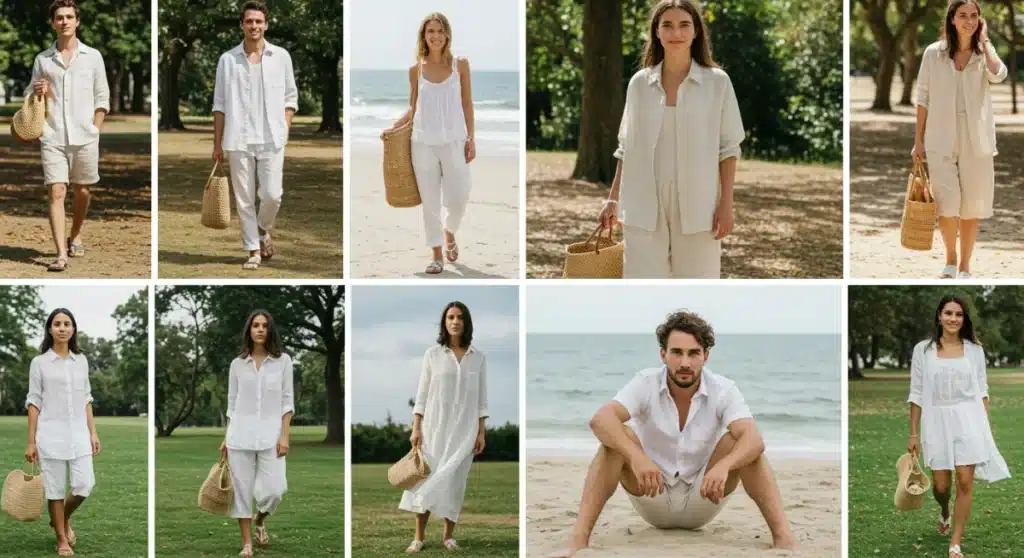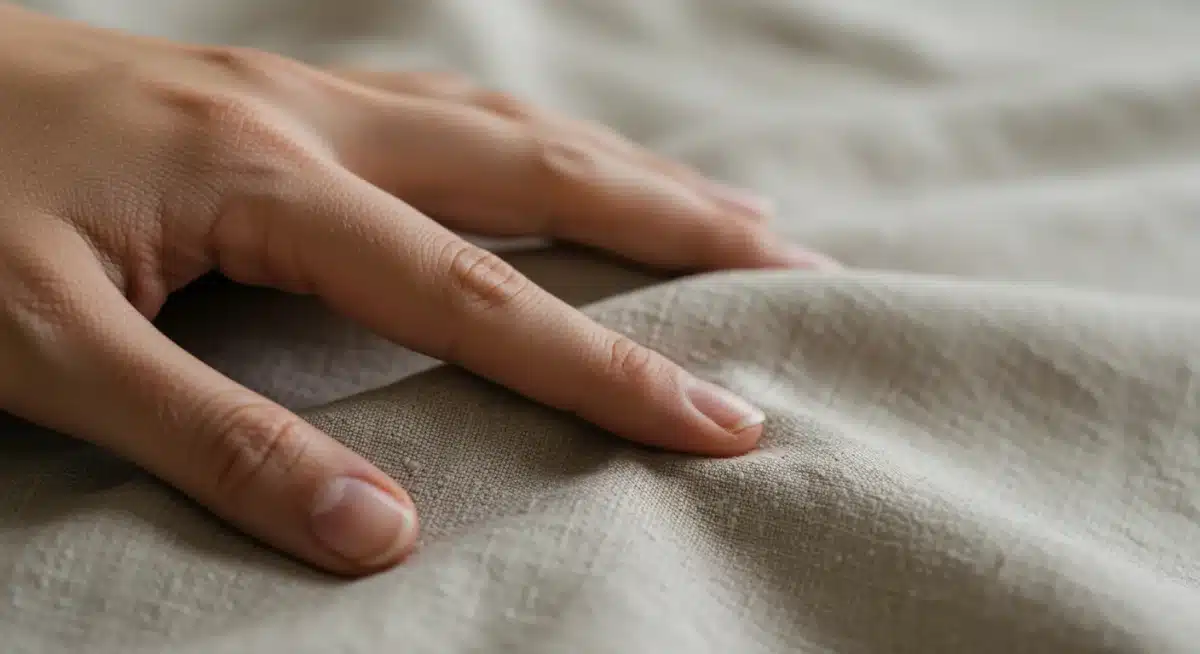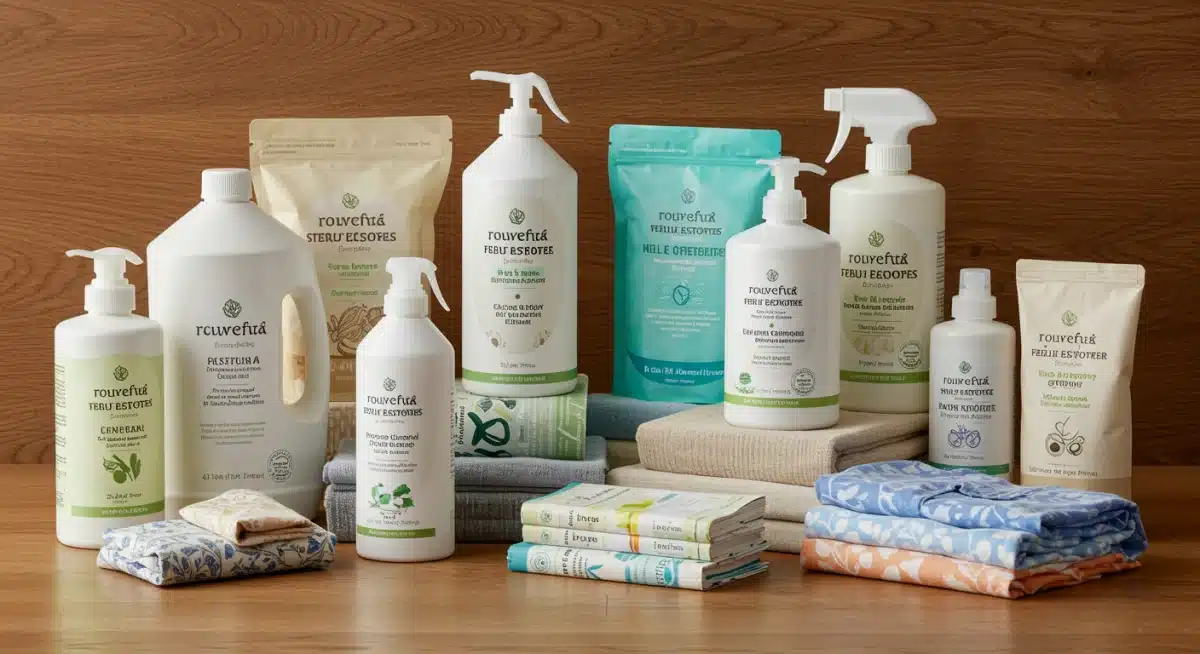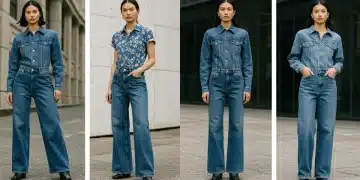2025’s Best Summer Fabrics: Comfort, Care, & Style

Advertisement
Staying comfortable and stylish in the summer heat means choosing the right fabrics that offer breathability and moisture-wicking properties, ensuring you remain cool and fresh throughout the season.
As the temperatures rise and the days stretch longer, the quest for comfortable yet stylish clothing becomes paramount. Navigating the myriad of options can be daunting, but understanding the characteristics of the best summer fabrics for 2025 is key to curating a wardrobe that keeps you cool, dry, and fashionable. This updated guide will delve into the top choices for summer comfort, offering insights into their unique properties and how to properly care for them to ensure longevity and sustained performance.
The Enduring Appeal of Natural Fibers for Summer
Natural fibers have long been the gold standard for summer apparel, and for good reason. Their inherent breathability, moisture-wicking capabilities, and soft touch against the skin make them ideal for combating heat and humidity. In 2025, these classic choices continue to dominate, with new innovations enhancing their appeal.
Advertisement
The beauty of natural fibers lies in their ability to adapt to your body’s needs, allowing air to circulate freely and helping to regulate body temperature. This makes them not just a comfortable choice, but a healthier one, reducing the likelihood of skin irritation and sweat-related discomfort during the hottest months of the year. Furthermore, many natural fibers are inherently sustainable, aligning with the growing consumer demand for eco-conscious fashion choices.
Linen: The Wrinkled Elegance
Linen remains an undisputed champion of summer fabrics. Derived from the flax plant, it is celebrated for its exceptional breathability and moisture-wicking properties. Its slightly coarser texture and natural tendency to wrinkle are often embraced as part of its charm, lending an effortlessly chic aesthetic to any outfit.
- Superior Breathability: Linen’s loose weave allows for maximum airflow, keeping you cool.
- Moisture Absorption: It can absorb a significant amount of moisture without feeling damp.
- Durability: Despite its delicate appearance, linen is incredibly strong and becomes softer with each wash.
- Hypoallergenic: Ideal for sensitive skin, as it resists bacteria and fungi.
Caring for linen is straightforward, though it does require attention to prevent excessive creasing. Washing in cool water and line drying can help maintain its structure and reduce the need for heavy ironing. For those who embrace its natural texture, a quick steam can often suffice to smooth out major wrinkles.
Advertisement
In summary, natural fibers like linen offer unparalleled comfort and style for summer, proving that some classics never go out of fashion. Their inherent properties make them perfect for warm weather, providing a refreshing alternative to synthetic materials.
Cotton: The Versatile Summer Staple
Cotton, often hailed as the king of fabrics, is a perennial favorite for summer due to its widespread availability, affordability, and exceptional comfort. Its soft touch and absorbent nature make it a go-to for everything from casual t-shirts to sophisticated summer dresses. In 2025, innovations in cotton processing continue to enhance its performance and sustainability.
From organic cotton to Pima and Egyptian varieties, the range of cotton available provides options for every preference and price point. Its versatility means it can be woven into various textures, from light and airy voile to sturdy denim, each offering unique benefits for summer wear. The natural fibers allow the skin to breathe, making it an excellent choice for everyday wear as well as for active pursuits during warmer months.
Organic Cotton: A Sustainable Choice
The demand for organic cotton has surged, reflecting a growing awareness of environmental impact. Organic cotton is grown without harmful pesticides and synthetic fertilizers, making it a more eco-friendly option. This not only benefits the planet but also ensures a purer, softer fabric against your skin.
- Reduced Environmental Impact: Supports healthier ecosystems and biodiversity.
- Softer Feel: Often perceived as softer and gentler due to minimal chemical processing.
- Hypoallergenic: Less likely to cause skin irritation for sensitive individuals.
- Durability: Maintains the natural strength and longevity of conventional cotton.
Caring for cotton is generally simple. Most cotton garments can be machine washed and dried, though checking care labels is always recommended to preserve color and prevent shrinkage. Using cold water and gentle cycles can also extend the life of your cotton clothing, keeping it looking fresh season after season.
The enduring popularity of cotton is a testament to its comfort and adaptability. Whether you opt for conventional or organic, cotton remains a reliable and stylish choice for staying cool and comfortable throughout the summer. Its ability to absorb moisture and allow air circulation makes it an indispensable part of any summer wardrobe.

Innovative Blends and Semi-Synthetics for Enhanced Performance
While natural fibers are excellent, modern textile technology has introduced innovative blends and semi-synthetic fabrics that offer enhanced performance characteristics, making them ideal companions for summer, especially for active lifestyles or specific climate conditions. These materials often combine the best attributes of natural and synthetic fibers, resulting in garments that are both comfortable and highly functional.
The development of these advanced fabrics addresses specific needs such as faster drying times, increased durability, and improved stretch, without sacrificing breathability. Many are engineered to manage moisture more effectively than traditional natural fibers, pulling sweat away from the skin to keep you dry and cool, even during intense activity. This makes them particularly suitable for athletic wear, travel clothing, and situations where quick drying is essential.
Tencel (Lyocell): Sustainable and Silky
Tencel, a brand name for lyocell, is a semi-synthetic fiber derived from wood pulp, primarily eucalyptus. It is highly regarded for its incredibly soft, silky feel, excellent breathability, and impressive moisture-wicking properties. The production process for Tencel is also environmentally responsible, utilizing a closed-loop system that recycles water and solvents.
- Softness: Often compared to silk, offering a luxurious feel.
- Moisture Management: Superior at wicking moisture away from the body.
- Sustainability: Eco-friendly production process.
- Drape: Creates beautiful, flowing garments that feel light and airy.
Caring for Tencel garments typically involves gentle washing to maintain their delicate texture. Machine washing on a delicate cycle with cold water and air drying is often recommended. Avoiding high heat can prevent shrinkage and preserve the fabric’s characteristic softness. Tencel’s resistance to wrinkles also means less ironing, adding to its appeal for busy individuals.
Modal, another rayon fiber made from beechwood pulp, shares many similarities with Tencel, offering a soft feel and good breathability. It’s often blended with cotton or spandex to enhance elasticity and durability. These semi-synthetics provide a compelling alternative for those seeking advanced performance without compromising on comfort or environmental considerations.
In conclusion, innovative blends and semi-synthetics like Tencel offer a fantastic balance of comfort, performance, and sustainability for summer wear. Their ability to manage moisture and maintain a soft feel makes them excellent choices for a dynamic summer wardrobe.
The Benefits of Specialized Synthetics for Active Summers
While natural and semi-synthetic fibers excel in many areas, certain specialized synthetic fabrics have carved out a significant niche for active summer lifestyles. These materials are engineered with specific performance goals in mind, such as extreme moisture-wicking, quick-drying capabilities, and enhanced durability, making them indispensable for sports, hiking, and other outdoor activities where staying dry and comfortable is paramount.
Modern synthetics, unlike their predecessors, are far from being hot and clammy. Advances in textile technology have led to the creation of fabrics that are incredibly lightweight, breathable, and designed to actively manage sweat, pulling it away from the skin to the fabric’s surface where it can evaporate quickly. This rapid moisture transfer is crucial for preventing chafing and maintaining a stable body temperature during strenuous exercise.
Polyester and Nylon: Engineered for Performance
Polyester and nylon are two of the most common synthetic fibers used in performance apparel. They are renowned for their strength, resistance to wrinkles, and ability to hold their shape. When treated with moisture-wicking technologies, they become excellent choices for athletic wear in warm weather.
- Moisture-Wicking: Efficiently moves sweat away from the skin.
- Quick-Drying: Dries rapidly, keeping you comfortable during and after activity.
- Durability: Highly resistant to abrasion, stretching, and shrinking.
- UV Protection: Many synthetic fabrics offer inherent UV protection, a bonus for outdoor activities.
Caring for synthetic activewear is generally straightforward. Most can be machine washed in cold water and tumble dried on a low setting. It’s often recommended to avoid fabric softeners, as they can clog the fibers and reduce the fabric’s moisture-wicking capabilities. Air drying is also a great option to extend the life of these garments and conserve energy.
Despite their synthetic origin, these fabrics have evolved significantly, offering solutions for specific summer needs where natural fibers might fall short in terms of rapid drying or extreme durability. They provide the necessary support and comfort for those who embrace an active summer, allowing them to perform at their best without being weighed down by sweat or heavy materials.
Understanding Fabric Weaves and Their Impact on Comfort
Beyond the fiber type, the way a fabric is woven significantly impacts its breathability, drape, and overall comfort in warm weather. Different weaves create distinct textures and structures that influence how air flows through the material and how it interacts with your skin. Understanding these variations can help you make more informed choices when selecting summer clothing.
A loose weave, for instance, naturally allows more air circulation, making the fabric feel lighter and cooler. Conversely, a tighter weave might offer more structure but could trap heat. The choice of weave can transform the same fiber into vastly different garments, each suited for different occasions and levels of warmth. This subtle detail often goes unnoticed but plays a crucial role in the comfort of your summer attire.
Plain Weave: Simplicity and Airiness
The plain weave is the simplest and most common type of textile weave. Each warp yarn passes over and under each weft yarn, creating a strong, durable, and often airy fabric. Many summer staples, such as broadcloth, muslin, and some types of linen, utilize a plain weave.
- Breathability: Generally very breathable due to its open structure.
- Lightweight: Often results in lighter fabrics.
- Durability: Known for its strength and resistance to tearing.
- Versatility: Can be made from various fibers, offering diverse appearances.
Another common weave suitable for summer is the open-knit. Think of fabrics like jersey or certain types of mesh. While technically a knit rather than a weave, open-knit structures provide excellent stretch and breathability, making them incredibly comfortable for activewear and casual summer garments. The loops in knit fabrics allow for a degree of elasticity and air circulation that can be very desirable in hot weather.
Understanding the impact of fabric weaves is essential for maximizing summer comfort. A well-chosen weave can enhance the natural properties of the fiber, ensuring your clothing feels as good as it looks, even on the hottest days. This attention to detail helps create a wardrobe that truly performs in warm climates.

Essential Care Tips for Your Summer Fabrics
Proper care is crucial for maintaining the integrity, appearance, and longevity of your summer wardrobe. The delicate nature of many lightweight fabrics, combined with the increased exposure to sweat, sunscreen, and environmental elements, means that a thoughtful approach to laundry and storage is essential. Neglecting proper care can lead to premature wear, fading, and loss of shape, diminishing the comfort and style of your favorite pieces.
Each fabric type has specific requirements, and adhering to these guidelines will not only extend the life of your garments but also ensure they continue to perform optimally in terms of breathability and comfort. Investing a little extra time in care can save you money in the long run by reducing the need for frequent replacements and keeping your clothes looking their best for many seasons to come.
General Guidelines for Fabric Care
While specific instructions vary by fabric, some general principles apply to most summer garments. These tips focus on preserving the fabric’s structure and color while effectively cleaning away summer residues.
- Read Care Labels: Always check the garment’s care tag for specific washing, drying, and ironing instructions.
- Separate by Color and Fabric Type: Wash whites, lights, and darks separately. Also, separate delicate fabrics from heavy items.
- Use Cold Water: Cold water helps prevent shrinkage, fading, and saves energy.
- Gentle Detergents: Opt for mild, eco-friendly detergents that are less harsh on fibers and the environment.
- Avoid Overloading the Washer: Give clothes enough space to move freely for a thorough clean without excessive friction.
Drying is another critical step. High heat can damage delicate fibers and cause shrinkage. Whenever possible, air-dry your summer clothes. Line drying in the shade can prevent sun damage and fading, while also being energy efficient. For items that require machine drying, use a low heat setting or the delicate cycle. Proper storage also plays a role; ensure clothes are clean and completely dry before storing them to prevent mildew and odors.
By following these essential care tips, you can significantly extend the life of your favorite summer fabrics. Thoughtful maintenance ensures that your clothing remains comfortable, vibrant, and ready to wear for many summers to come, delivering sustained performance and style.
Sustainable Summer Fashion: Making Conscious Choices
In 2025, the conversation around fashion has increasingly shifted towards sustainability. Choosing the best summer fabrics now involves not just comfort and style, but also considering the environmental and social impact of our clothing choices. Sustainable summer fashion encourages consumers to look beyond immediate gratification and think about the lifecycle of their garments, from production to disposal.
This movement is driven by a growing awareness of the fashion industry’s footprint, prompting both brands and consumers to seek out more responsible alternatives. Opting for sustainably produced fabrics and supporting ethical brands contribute to a healthier planet and fairer labor practices. It’s about making conscious decisions that align with our values, without compromising on personal style or comfort during the warmer months.
Embracing Eco-Friendly Materials
A key aspect of sustainable summer fashion is prioritizing materials that have a lower environmental impact. This includes natural fibers grown organically, recycled materials, and innovative fabrics with closed-loop production processes. Each choice contributes to reducing waste, conserving resources, and minimizing pollution.
- Organic Cotton and Linen: Grown without harmful chemicals, promoting healthier soil and water.
- Recycled Polyester: Made from plastic bottles, reducing plastic waste and energy consumption.
- Hemp: A highly sustainable crop that requires minimal water and no pesticides, producing durable fibers.
- Tencel and Modal: Produced using eco-friendly closed-loop systems, minimizing chemical and water waste.
- Upcycled Fabrics: Giving new life to existing textiles, reducing demand for new production.
Beyond material choices, sustainable fashion also encompasses practices such as buying fewer, higher-quality items, repairing clothes instead of discarding them, and donating or recycling garments at the end of their life. Investing in durable, timeless pieces made from sustainable fabrics not only benefits the environment but also often results in a more versatile and long-lasting wardrobe. These garments are designed to withstand trends and provide comfort for many seasons.
Ultimately, making conscious choices about our summer fabrics and consumption habits is a powerful step towards a more sustainable future for fashion. By selecting eco-friendly materials and adopting responsible care practices, we can enjoy comfortable and stylish summers while contributing positively to the planet.
Styling Your Summer Fabrics for Every Occasion
Once you’ve identified the best summer fabrics, the next step is to master the art of styling them for various occasions. Summer fashion is all about effortless elegance, comfort, and adaptability. The right fabric choice can elevate an outfit, ensuring you not only look good but also feel great, whether you’re heading to a casual beach day, a formal garden party, or a relaxed evening out.
The beauty of summer fabrics lies in their inherent versatility. Linen, for instance, can transition from a casual beach cover-up to a chic dinner ensemble with the right accessories. Cotton, in its many forms, offers a foundation for countless looks, from crisp office wear to laid-back weekend attire. The key is to understand how each fabric drapes, its texture, and how it pairs with different silhouettes and accessories to create a cohesive and comfortable outfit.
From Casual to Chic: Versatile Styling
Leveraging the natural properties of your summer fabrics can help you create outfits that are both stylish and practical. Think about layering lightweight pieces, playing with textures, and incorporating accessories that complement the airy feel of your garments.
- Linen: Pair linen trousers with a fitted cotton tank for a casual look, or a linen blazer over a silk camisole for a sophisticated evening.
- Cotton: Opt for a crisp cotton poplin dress for a daytime event, or soft cotton jersey separates for ultimate relaxation.
- Tencel: Its fluid drape makes Tencel perfect for elegant blouses and flowy skirts that can be dressed up or down.
- Hemp: Embrace its rustic texture in wide-leg pants or durable shirts for a relaxed, earthy vibe.
Accessorizing plays a vital role in transforming summer fabric outfits. Lightweight scarves, straw hats, and open-toe footwear can enhance the summery feel. For a more polished look, consider delicate jewelry and structured handbags that contrast with the relaxed nature of the fabrics. The goal is to create outfits that feel light and breezy, reflecting the season’s carefree spirit without sacrificing style.
By thoughtfully styling your summer fabrics, you can create a wardrobe that is both functional and fashionable. Experiment with different combinations and accessories to discover how these materials can be adapted to suit any summer occasion, ensuring you always look and feel your best.
| Fabric Type | Key Benefit for Summer |
|---|---|
| Linen | Exceptional breathability and moisture-wicking, with a natural, elegant drape. |
| Cotton | Versatile, soft, and highly absorbent, available in various sustainable forms. |
| Tencel (Lyocell) | Silky soft, highly moisture-wicking, and sustainably produced for comfort. |
| Polyester/Nylon Blends | Engineered for rapid drying and extreme moisture-wicking, ideal for active wear. |
Frequently Asked Questions About Summer Fabrics
For very hot and humid conditions, linen is often considered the top choice. Its loose weave and natural fibers allow for exceptional airflow, preventing heat buildup and wicking moisture away from the skin efficiently, keeping you feeling cool and dry even in challenging climates.
Yes, specialized synthetic fabrics like those made from moisture-wicking polyester or nylon blends are excellent for active summers. They are engineered to pull sweat away from the skin and dry quickly, making them ideal for exercise, outdoor sports, or situations where rapid drying is crucial.
To extend the life of your summer clothes, always read care labels, wash in cold water with mild detergents, avoid overloading the machine, and air-dry whenever possible. Proper storage in a cool, dry place also prevents damage and preserves fabric integrity.
Tencel (Lyocell) is a sustainable semi-synthetic fiber derived from wood pulp. It’s excellent for summer due to its incredibly soft, silky feel, high breathability, and superior moisture-wicking properties, making it comfortable and cooling. Its eco-friendly production is an added benefit.
Conclusion
Choosing the right fabrics is paramount for a comfortable and stylish summer. As we’ve explored, from the classic breathability of linen and cotton to the innovative performance of Tencel and specialized synthetics, a wide array of options exists to keep you cool and dry in 2025. Coupled with diligent care and a mindful approach to sustainable fashion, your summer wardrobe can be both a source of personal comfort and a reflection of responsible choices. Embrace these fabrics and care tips to enjoy every sunny day to its fullest, ensuring your style remains effortless and your comfort uncompromised.





